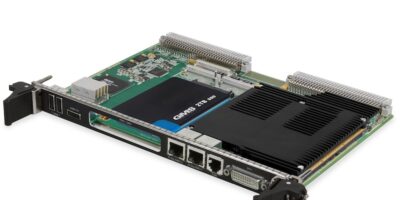VME board integrates latest Intel CPUs for naval combat and control systems
Fourth-generation VME single board computers (SBCs) from General Micro Systems (GMS) can be used to upgrade Navy platforms to include the latest Intel processing and graphics performance and maintain backwards compatibility with legacy programmes.
The Aegis combat system, DDGx and other Navy programs have relied on GMS VME SBCs for fire control, engine control, machinery control, and operator console displays. Evolving software requirements and program enhancements mandate performance higher than that provided by the original VME boards. The VME120 versions maintain backward compatibility with legacy systems and add Intel Kaby Lake Core i7 processors and updated graphics features.
The VME SBCs are designed for technology refresh/insertion and easy pre-planned product improvement (P3I) using the same backplane, signal positions and front panel connections. The model can be simply plugged in and software loaded for an upgrade.
GMS has been building VME boards and systems for over 30 years. The company’s VME boards and systems use a modular core which contains the processor that can be evolved as technology changes over time. The engine plugs onto a VME base carrier board with system interfaces that change very slowly, if at all, notes GSM. The processor and memory evolve with Moore’s Law, while connections to the VME system remain constant and predictable.
The VME120 is available in three versions. There is a single-slot version that replaces fourth generation Intel Haswell processors and two dual-slot versions. One of the dual-slot versions replaces an earlier fourth generation Intel processor and the other replaces an earlier Motorola PowerPC CPU.
In the single-slot version, a PMC or XMC I/O board, or a SATA SSD can be mounted on the board to provide both backplane and front-panel I/O. The dual-slot versions add a PCI Express Workstation I/O (WSIO) mezzanine carrier card that supports additional I/O mezzanines, with MXM (1x), PMC or XMC (3x) options. Collectively, the VME120-WSIO reduces a chassis’ worth of VME boards into two slots. The card can support VME32, VME64, 3- and 6-row VME connectors, and a centre P0 connector, depending on the variant.
The 3.0MHz Kaby Lake Xeon E3-1505M CPU is mated to 64Gbyte of DDR4 DRAM with error code correction (ECC). I/O includes two 10GbE to the front panel, two 1GbE to the backplane, four SATA ports, four serial ports, one USB 3.0 and two USB 2.0, a super I/O Com port to the front panel, HDMI and VGA to the backplane, and 16 GPIO on P2. Used with operator consoles, it also includes line in and mic in, plus headphone audio output.
The VME120 supports the user’s choice of an XMC/PMC with front panel I/O or a SATA SSD mounted on the SBC. The dual-slot VME120-WSIO provides up to three additional XMC/PMC sites, or two sites with an add-on MXM. When equipped with an MXM, the SBC supports triple video outputs, with options for dual VGA and sync- on-green for legacy military consoles.
http://www.gms4sbc.com




